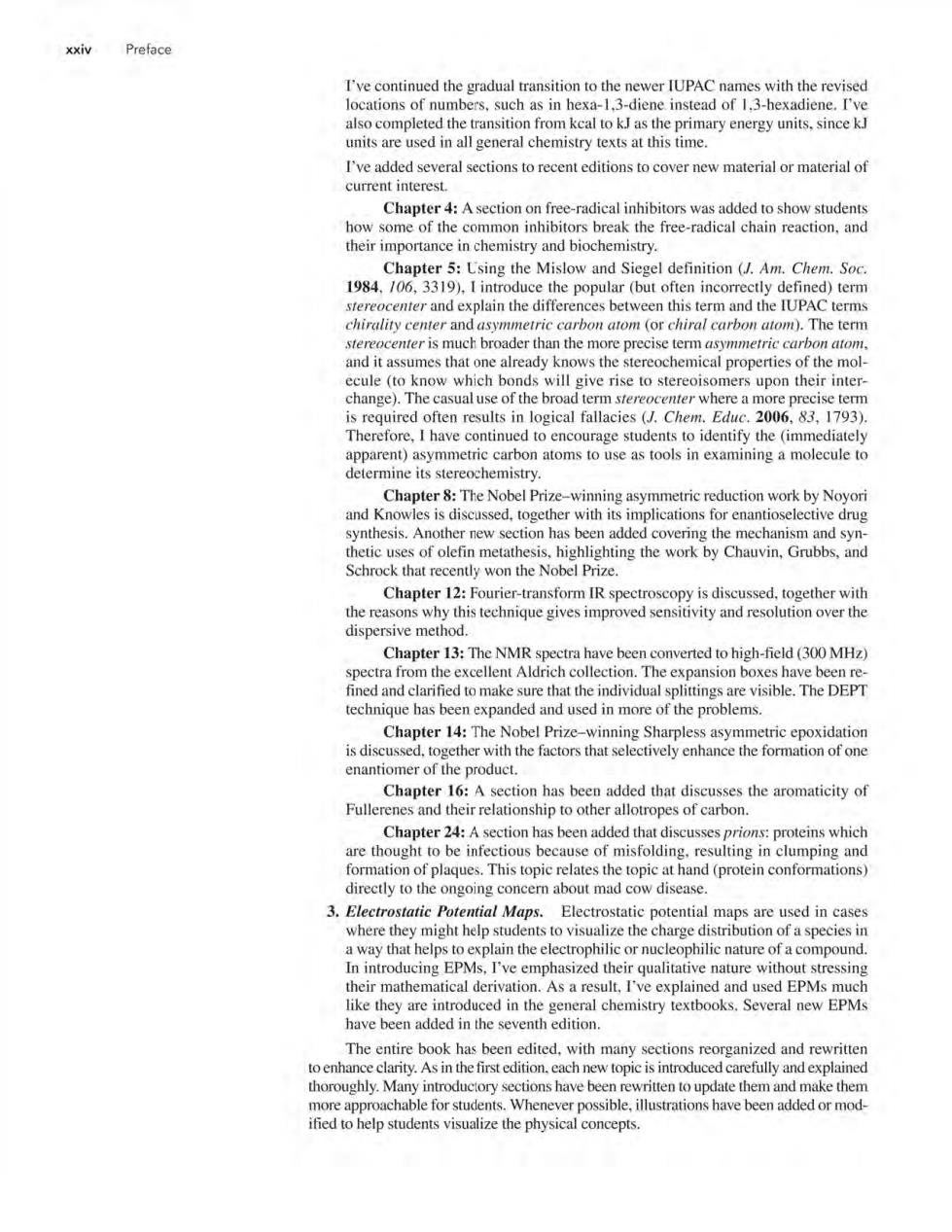正在加载图片...

Preface I've continued the gradual transition to the newer IUPAC names with the revised locations of numbers,such as in hexa-1.3-diene instead of 1.3-hexadiene.I've d in al general chemistry I've added several sections to recent editions to cover new material or material of current interest I definition (J. e the stereocenter and explain the differences between this term and the IUPAC terms chirality center and asymmetric carbon arom (o chiral carbon atom).The term ocenter is much bro der than the more precise term asymmetric c ge).The casual use of the broad term stercer nere a more prees is required often results in logical fallacies Chem.Educ t)ac nna molecule to tric reduction work by Novori ynthesis.Anc new section has been heticuses metat added covering the mechanism and syn the Noh hting the work by Chauvin,Grubbs.and Chapte IR spec is dis ogether with Chapter 13:The NMr s tra have hee nverted to high-field (300 MHz) fined and clarified to make sure that the individual splittings are visible.The DEPT technique has be expanded and used in more of the problems Chapter 14:The Nobel Prize-winning Sharpless asymmetric epoxidation n the factors that selectively enhance the formation of one apterelaioashiptotheralot added that d the aromaticity of s of carbor 24.A h o and formation of plaques.This topic relates the topic at hand (protein conformations) directly to the ongoing concern about mad cow disease. 3.Electrostatic Potential Maps.Electrostatic potential maps are used in cases n the electroph he or nu ature or a compoun their mathematical derivation.resul.Iv epned and used EPMs much like they are introduced in the general chemistry textbooks.Several new EPMs have been added in the seventh edition. The entire book has been edited,with many sections reorganized and rewritten toenhance clarity.As in the first edition.each new topic is introduced carefully and explained thoroughly.M d or mo nts xxiv Preface I've continued the gradual transition to the newer IUPAC names with the revised locations of numbers, such as in hexa-1,3-diene instead of 1,3-hexadiene. I've also completed the transition from kcal to kJ as the primary energy units, since kJ units are used in all general chemistry texts at this time. I've added several sections to recent editions to cover new material or material of current interest. Chapter 4: A section on free-radical inhibitors was added to show students how some of the common inhibitors break the free-radical chain reaction, and their importance in chemistry and biochemistry. Chapter 5: Using the Mislow and Siegel definition (1. Am. Chern. Soc. 1984, 106, 3319), I introduce the popular (but often incorrectly defined) term stereocenter and explain the differences between this term and the IUPAC terms chirality center and asymmetric carbon atom (or chiral carbon atom). The term stereocenter is much broader than the more precise term asymmetric carbon atom, and it assumes that one already knows the stereochemical properties of the molecule (to know which bonds will give rise to stereoisomers upon their interchange). The casual use of the broad term stereocenter where a more precise term is required often results in logical fallacies (1. Chern. Educ. 2006, 83, 1793 ). Therefore, I have continued to encourage students to identify the (immediately apparent) asymmetric carbon atoms to use as tools in examining a molecule to determine its stereochemistry. Chapter 8: The Nobel Prize-winning asymmetric reduction work by Noyori and Knowles is discussed, together with its implications for enantioselective drug synthesis. Another new section has been added covering the mechanism and synthetic uses of olefin metathesis, highlighting the work by Chauvin, Grubbs, and Schrock that recently won the Nobel Prize. Chapter 12: Fourier-transform IR spectroscopy is discussed, together with the reasons why this technique gives improved sensitivity and resolution over the dispersive method. Chapter 13: The NMR spectra have been converted to high-field (300 MHz) spectra from the excellent Aldrich collection. The expansion boxes have been refined and clarified to make sure that the individual splittings are visible. The DEPT technique has been expanded and used in more of the problems. Chapter 14: The Nobel Prize-winning Sharpless asymmetric epoxidation is discussed, together with the factors that selectively enhance the formation of one enantiomer of the product. Chapter 16: A section has been added that discusses the aromaticity of Fullerenes and their relationship to other allotropes of carbon. Chapter 24: A section has been added that discusses prions: proteins which are thought to be infectious because of misfolding, resulting in clumping and formation of plaques. This topic relates the topic at hand (protein conformations) directly to the ongoing concern about mad cow disease. 3. Electrostatic Potential Maps. Electrostatic potential maps are used in cases where they might help students to visualize the charge distribution of a species in a way that helps to explain the electrophilic or nucleophilic nature of a compound. In introducing EPMs, I've emphasized their qualitative nature without stressing their mathematical derivation. As a result, I've explained and used EPMs much like they are introduced in the general chemistry textbooks. Several new EPMs have been added in the seventh edition. The entire book has been edited, with many sections reorganized and rewritten to enhance clarity. As in the first edition, each new topic is introduced carefully and explained thoroughly. Many introductory sections have been rewritten to update them and make them more approachable for students. Whenever possible, illustrations have been added or modified to help students visualize the physical concepts